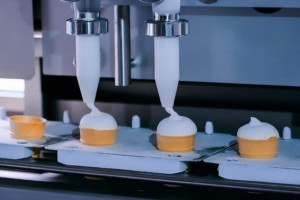 In my last two posts I talked on how to set up a changeover wheel or, more generally, a changeover sequence. Next I will show you how to use a changeover wheel. The idea is simple, but there are some pitfalls as well as some tricks to make it easier. Let’s have a look.
In my last two posts I talked on how to set up a changeover wheel or, more generally, a changeover sequence. Next I will show you how to use a changeover wheel. The idea is simple, but there are some pitfalls as well as some tricks to make it easier. Let’s have a look.
Sequencing
A Few More Turns on the Changeover Wheel – Part 4: Options for Prioritizing
A Few More Turns on the Changeover Wheel – Part 3: Prioritizing Jobs
 In my last posts I talked on how to set up a changeover wheel or, more generally, a changeover sequence. Next I will show you how to use a changeover wheel. You have to fit you prioritized production into the sequence. The idea is simple, but there are some pitfalls as well as some tricks to make it easier. I will talk more about the pitfalls in my next post. Let’s have a look on how to fill the changeover wheel with actual production jobs.
In my last posts I talked on how to set up a changeover wheel or, more generally, a changeover sequence. Next I will show you how to use a changeover wheel. You have to fit you prioritized production into the sequence. The idea is simple, but there are some pitfalls as well as some tricks to make it easier. I will talk more about the pitfalls in my next post. Let’s have a look on how to fill the changeover wheel with actual production jobs.
A Few More Turns on the Changeover Wheel – Part 2: Improving the Sequence
 In my last post I looked at how to create a changeover sequence. However, this was only the first draft of such a sequence. For a truly good sequence, you need to spend some more time optimizing the sequence. Try to get a better sequence, even though it is impossible to find the perfect solution even for a moderate number of products. I also give a suggestion on how to visualize a changeover wheel in Excel.
In my last post I looked at how to create a changeover sequence. However, this was only the first draft of such a sequence. For a truly good sequence, you need to spend some more time optimizing the sequence. Try to get a better sequence, even though it is impossible to find the perfect solution even for a moderate number of products. I also give a suggestion on how to visualize a changeover wheel in Excel.
A Few More Turns on the Changeover Wheel – Part 1: Creating a Sequence
 The changeover wheel is a visualization of a good changeover sequence. In this series of posts I will go deeper on how to use such a changeover sequence in planning your production sequence. The concept itself is simple, but there are still some pitfalls in using it. This first post looks deeper at generating a first sequence. My next post will then optimize the sequence, where we will also learn why you probably should not shoot for the perfect solution, but merely for good enough.
The changeover wheel is a visualization of a good changeover sequence. In this series of posts I will go deeper on how to use such a changeover sequence in planning your production sequence. The concept itself is simple, but there are still some pitfalls in using it. This first post looks deeper at generating a first sequence. My next post will then optimize the sequence, where we will also learn why you probably should not shoot for the perfect solution, but merely for good enough.
Changeover Sequencing under Duress: Problems with Make and Deliver
 In my last post I looked at strategies to manage changeover sequencing if your supplier gives you trouble. Basically, you can sometimes reduce the damage by fine-tuning the prioritization (i.e., by using the limited raw materials to make the most important parts). This second post in this series looks at similar situations if your customer acts up, or if your own system makes problems. In other words, after discussing “source” in the last article, we now look at the “make” and “deliver” part. Admittedly, some of the approaches are similar to the problems with “source.”
In my last post I looked at strategies to manage changeover sequencing if your supplier gives you trouble. Basically, you can sometimes reduce the damage by fine-tuning the prioritization (i.e., by using the limited raw materials to make the most important parts). This second post in this series looks at similar situations if your customer acts up, or if your own system makes problems. In other words, after discussing “source” in the last article, we now look at the “make” and “deliver” part. Admittedly, some of the approaches are similar to the problems with “source.”
Changeover Sequencing under Duress: Problems with Source
 Changeover sequencing helps you to produce more efficiently with smaller lot sizes, less inventory, and/or less changeovers. But despite a good changeover sequence, sometimes things blow up in your face. Your supplier does not deliver, your customer wants more than you planned, or your main process went belly-up and is waiting for repairs. In any case, something is forcing your hand and messing up your changeover sequence, or more generally your entire production sequence. What do you do? Well, depending on what happened, you may have options to mitigate the damage. This first post will look at mishaps originating from your supplier, and the next post will look at difficulties originating from your customer or even from your own system.
Changeover sequencing helps you to produce more efficiently with smaller lot sizes, less inventory, and/or less changeovers. But despite a good changeover sequence, sometimes things blow up in your face. Your supplier does not deliver, your customer wants more than you planned, or your main process went belly-up and is waiting for repairs. In any case, something is forcing your hand and messing up your changeover sequence, or more generally your entire production sequence. What do you do? Well, depending on what happened, you may have options to mitigate the damage. This first post will look at mishaps originating from your supplier, and the next post will look at difficulties originating from your customer or even from your own system.
Replenishment Time Stability for Changeover Sequencing
 Changeover sequencing is simply creating a production sequence that reduces the changeover effort. For example, in injection molding, colors are often changed from light to dark to reduce the cleaning effort. However, like all production sequencing (like leveling, lot sizing, prioritization,….), it adds to the replenishment time. Especially if you are using pull production, a consistent replenishment time reduces fluctuations, whereas an inconsistent replenishment time increases fluctuations and hence waste. But how can we get a more consistent replenishment time?
Changeover sequencing is simply creating a production sequence that reduces the changeover effort. For example, in injection molding, colors are often changed from light to dark to reduce the cleaning effort. However, like all production sequencing (like leveling, lot sizing, prioritization,….), it adds to the replenishment time. Especially if you are using pull production, a consistent replenishment time reduces fluctuations, whereas an inconsistent replenishment time increases fluctuations and hence waste. But how can we get a more consistent replenishment time?

